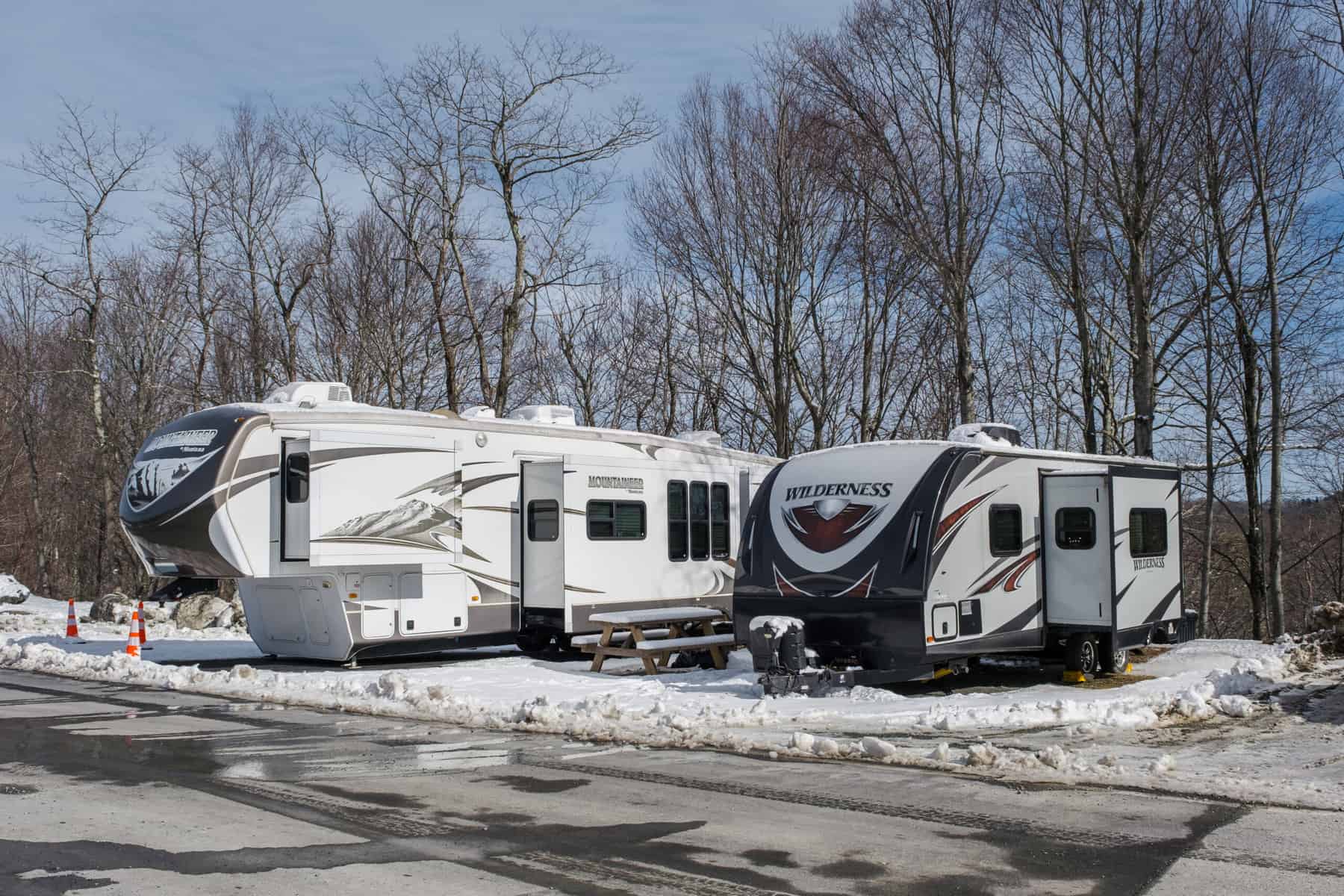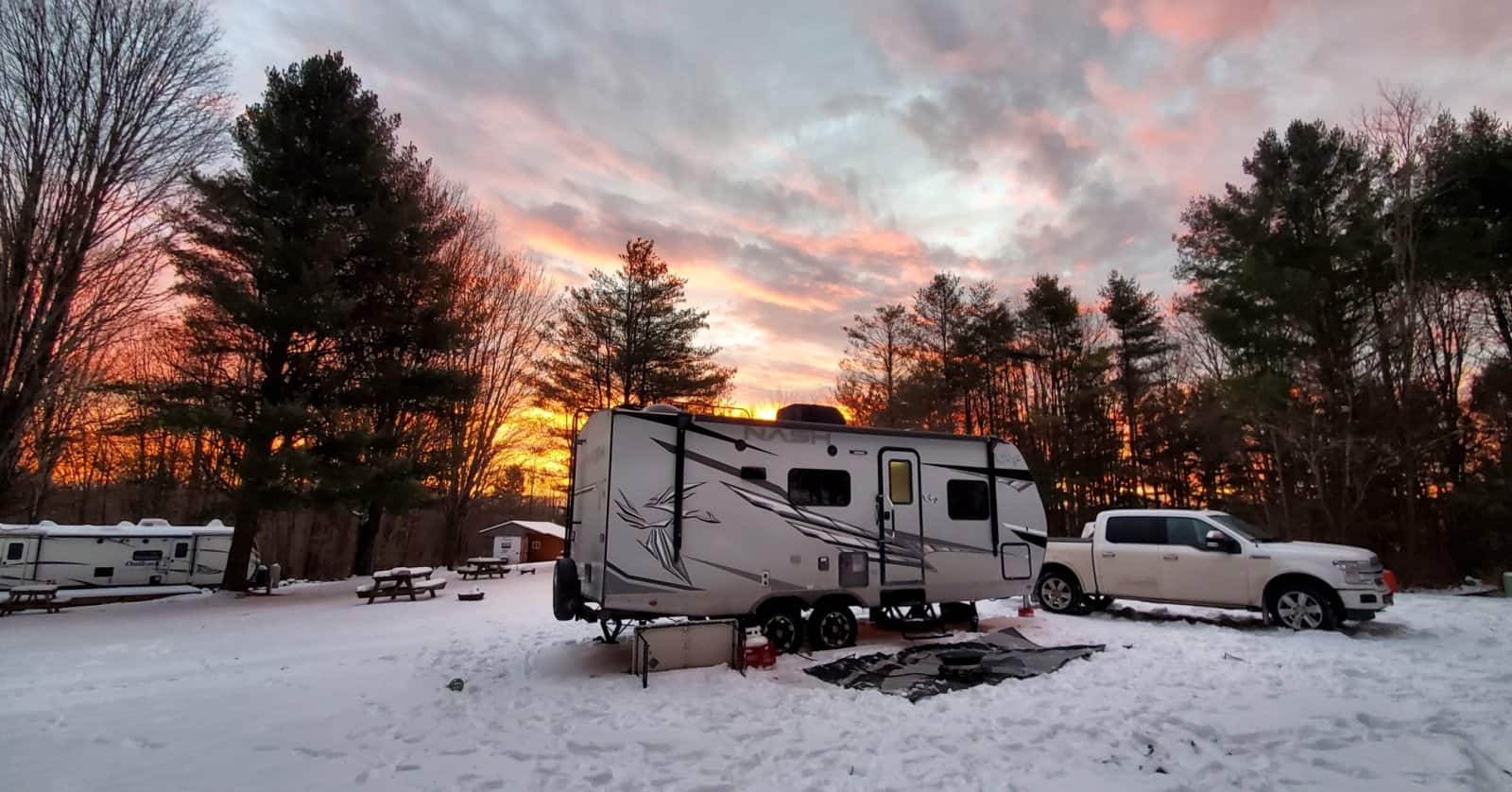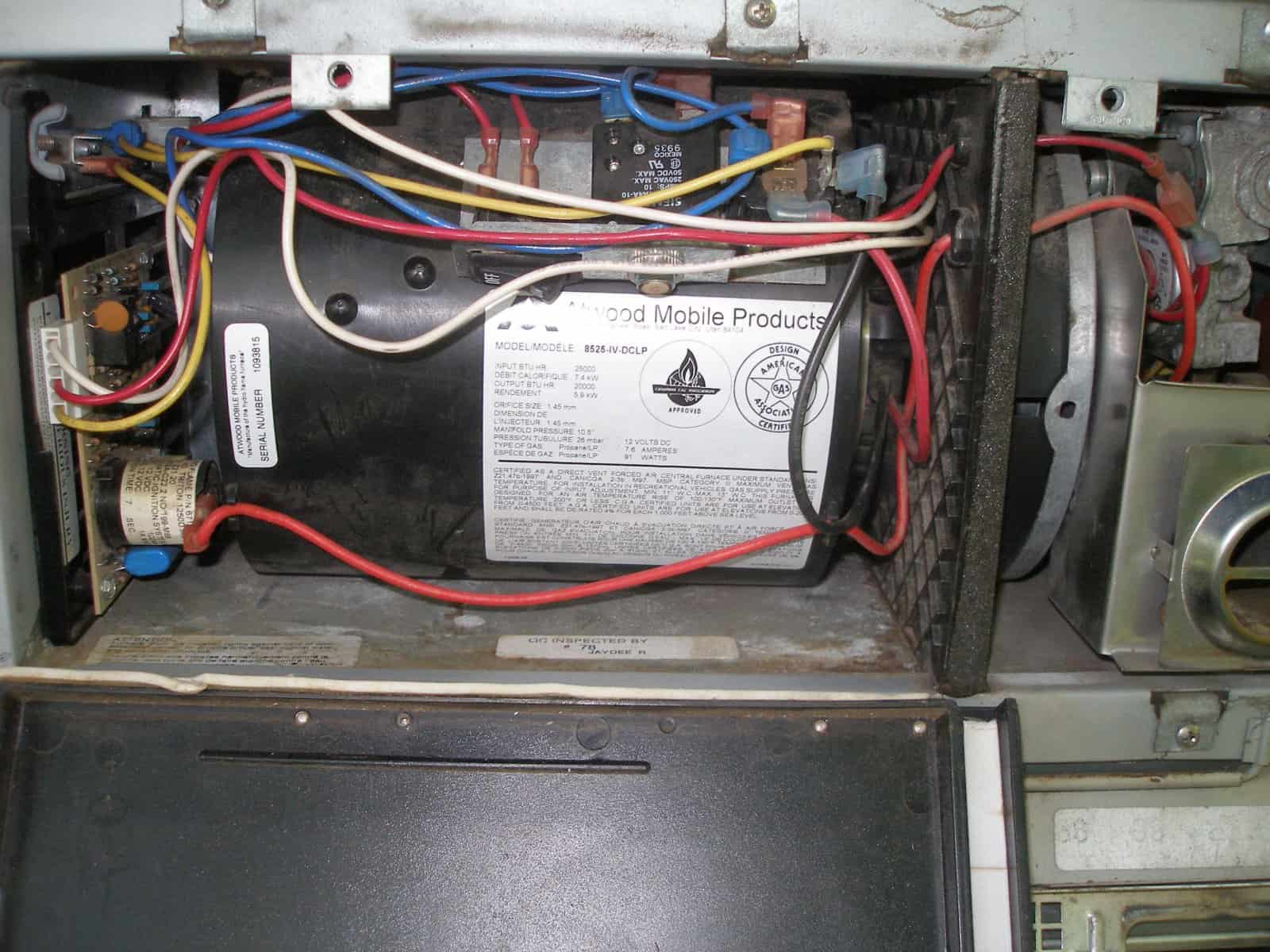Winter will be here before you know it, and so will the long list of potential problems many people encounter when trying winter RV camping. From refrigerators that stop working, to frozen water lines, and the dreaded sewer hose “poopsicle,” let’s review the many cold weather RVing hassles you might encounter.
And don’t worry, we also address some easy ways to prevent or fix those winter RV camping problems. Learn tips for installing heat tape, adding RV skirting, and even melting a “poop-sicle” with RV antifreeze and hot water.
The 7 Biggest Cold Weather Camping Problems (and Fixes)
If your RV has any type of insulation, you have every chance of staying nice and comfy while cold weather camping. But there are some pre-trip steps you need to take before giving it a try. In order to ensure you don’t make dumb winter camping mistakes, let’s review what you need to know.
First, even the best RVs do not hold up well in cold weather. Sure, some RV manufacturers like Northwood and Outdoor RV make 4-season RVs, but even these rigs touted as “year round” travel trailers or motorhomes can still develop problems when temperatures drop below freezing.
Here are the top 6 winter RV camping problems most RVers with just about any make and model are likely to encounter, and what you can do to avoid these hassles.
1. Frozen RV Water Hose
We all know that water freezes, so it should come as no surprise that any of it lingering in your RV water hose, fresh water tank, plumbing lines, and sewer hoses can freeze too. Camping without running water isn’t fun, but you don’t have to sacrifice that comfort in cold weather. Here’s how to avoid a frozen RV water hose.
- Invest in a high quality heated RV water hose. Many of these heavily insulated fresh water hoses can deliver fresh water even in subzero temperatures. They’re a great choice during cold spells, but a word of warning: You may be told by your park manager to disconnect your water hoses–even if it’s heated. The problem is that if the campground isn’t set up for cold winter RV camping, even the best heated RV water hose won’t prevent an exposed campsite water spigot from freezing and bursting.
- Install plumbing heat tape. Any fan of winter RV camping will tell you that heat tape is one of the most essential cold weather RVing tools to keep fresh water flowing. Attach one end to your city water connection and run the other along the outside of your RV water hose before enclosing it in foam insulation. But don’t just rely onheat tape hearsay; follow all product installation directions, or you could damage plumbing and possibly cause a fire.
- Ultimately, the best way to avoid a frozen water hose is to stop using it. Just keep your fresh water tank full when the temperature goes below freezing. If you have an RV underbelly with insulation, you should still be able to use your fresh water tank in relatively cold weather.
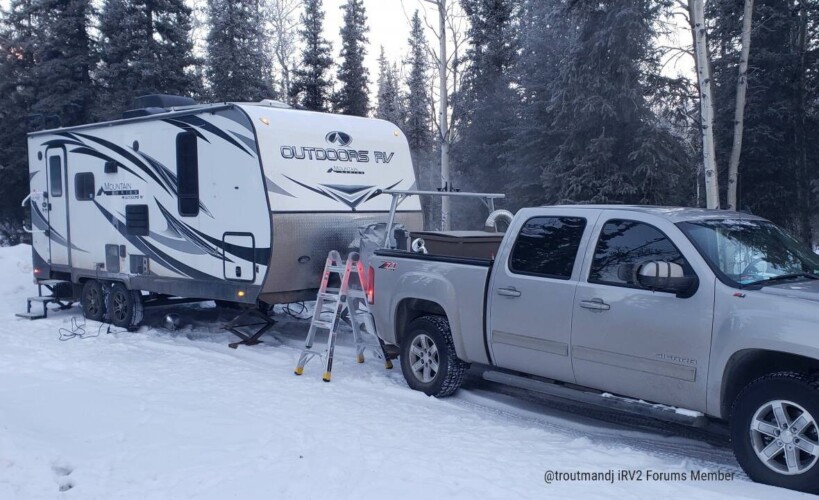
key in extreme weather is to run the generator constantly or intermittently but at least every 3 hours, maybe 2.
@troutmandj, iRV2 Forums Member
2. Frozen Water and Holding Tanks
Sometimes despite your best effort, your RV water tanks can freeze. This often result in pipe cracks, leaks, and probably a broken RV toilet, too. You want to do all you can to avoid one of the most expensive repairs caused by winter camping.
If your RV has an “Arctic Package” with a well-insulated, 4-season underbelly, your odds of frozen water lines and holding tanks go down exponentially. But if you don’t have high quality insulation, here are the two biggest things you can do to prevent frozen water and holding tanks.
- Install RV tank heaters. These are inexpensive heated pads that come in all shapes and sizes. They attach to the outside of your RV water and holding tanks to keep them warm, and prevent freezing. By connecting RV tank heaters to your electrical system, their built-in thermostats can switch on-and-off as needed so you don’t have to think about when to use them.
- Add RV skirting around your rig. This insulation protects your RV underbelly from frozen temperatures by restricting airflow. RV skirting can be made with any type of protective material that surrounds the lower portion of your RV. It can improve your rig’s heating efficiency, and sure beats using Irish Spring as a rodent deterrent.
WARNING: Do not fall for the myth of leaving your water faucet tap dripping at night.
When we got here to Virginia last week someone suggested we leave the gray open and drip our faucets. Well, that worked fine until today when I noticed the gray tank showed 2/3 full. I looked outside and the sewer hose was frozen solid. I guess a low spot froze and then got worse as more water slowly trickled down the hose. I had to destroy it to remove it.
@stevel720, iRV2 Forums member
Many RVers say that running water can’t freeze. But that’s not true. I’ve tried this recommendation, and discovered that dripping water flowing through an RV water hose in freezing temperatures can still freeze.
Also, if your gray water tank valve is closed because you’re trying to avoid a frozen RV sewer hose, that dripping water can flood the inside of your rig. Just avoid it altogether.
3. The Dreaded Poop-sicle
My black tank is full and I went to dump it and nothing comes out? It froze once before and I just added rvantifreeze and that fixed it. This time I think it’s frozen down by the gate valve. Any ideas out there? Thanks
@James FTRVr, iRV2 Forums
It can happen to the most experienced RVer camping in freezing temperatures. They go outside to dump the black water tank and nothing comes out. The cause? Frozen waste water in your tanks, and a frozen RV sewer hose are the culprit.
Once you have an RV poop-sicle in your blackwater tank, you won’t be able to use your RV toilet. RVers who have had this happen say that the best way to speed up RV poop-sicle melting is to slowly pour hot water and RV antifreeze down your toilet. Use care not to overfill, and wait for the ambient temperature to rise above freezing before you expect to see results.
This video shows a helpful way to prevent the dreaded RV-poopsicle from forming in the first place.
4. The High Cost of RV Heat
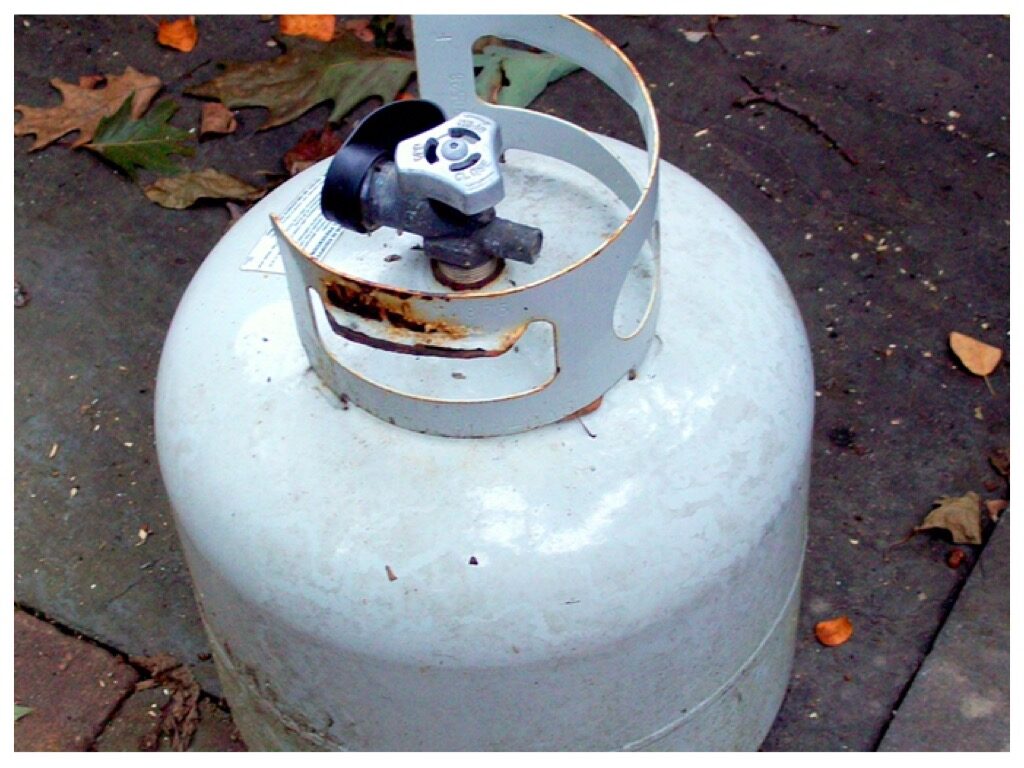
Running your RV furnace day in and day out all winter will burn through your propane faster than usual. If you are winter camping in an RV park with electricity included in campsite fees, take advantage of that generosity by running electric space heaters instead. But if you are paying for electricity, always consider the cost using an RV propane heater versus an electric space heater.
Just an FYI, be sure to use your propane furnace on occasion if you are using an electric space heater. Only the furnace will provide heat to the basement and underbelly area.
@MtCamper, iRV2 Forums Member
What about electric space heaters in an RV?
In our article “RV Propane Heater vs. Electric Space Heater,” our RV tech expert Dave Helgeson suggests taking into account the efficiency of both types of RV heat. Many times, RV propane heat will actually cost more than electric heat because of their lack of efficiency. “There is no clear answer regarding which costs less. Review the advantages of each energy source. This may provide you the answer to the propane heater vs. electric heater question,” he says.
5. Excessive Condensation
Thinking of adding an extra heater to your RV? You might want to think twice about the type you use. One of the biggest problems with indoor-safe catalytic heaters is they release more moisture into the air than an RV stove, oven, or furnace. But even if you opt for an electric heater, you’ll likely experience excessive condensation in your RV.
Cooking, breathing, and showering in an enclosed rig also leads to an incredible amount of dampness inside. The moisture collects on the walls, windows, and in cabinets, causing mildew, and sometimes water damage if it pools up in hidden areas. But there are things you can do to reduce the impact.
- Cook with electric appliances. Use your gas stovetop and oven as sparingly as possible.
- Shower in the campground bathroom. Keeping shower steam out of your rig makes a big difference.
- Run your RV fans while cooking on the stove or in the oven, running hot water, or doing laundry in the RV if you have these appliances.
- Use an RV-sized dehumidifier and DampRid moisture-absorber in cabinets and the bedroom.
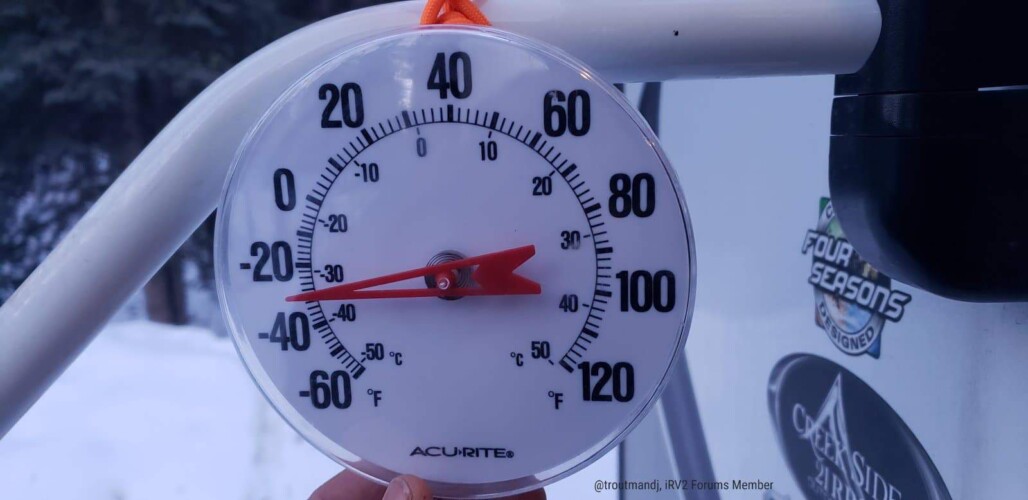
6. A Fussy RV Refrigerator
Any RVer who has camped in cold weather will tell you that RV absorption refrigerators hate cold weather. In this article, “My RV Refrigerator in Cold Weather,” we learn that the refrigerator keeps things cold with a mixture of ammonia and water. In extreme cold, the water freezes inside the fridge and halts the cooling process. “This not only stops the fridge from cooling, but it can also destroy the refrigerator. The result of the destruction can be a dangerous RV fire,” says RV refrigeration expert Paul Unmack.
Another possible cause of cold weather fridge problems has to do with cold outside air reaching the thermostat sensor. The sensor tells the fridge that it is cold and causes it to stop running, even if the actual fridge temperature is not as cold as it should be.
To trick the sensor into the right operating temperature, try blocking the top two fridge vent slots with a nonflammable material.
The solution is to reduce the venting, maybe even block one of them completely, or place a 120v incandescent light bulb (if you can find one anymore) in the back to help keep it warmer back there. You can use an infrared heat lamp if you can’t find a 60-75 watt incandescent.
Norcold & Dometic both even sell a cold weather kit if you expect to use it often in extreme cold.
@jblack2743, iRV2 Forums Member
Finally, if you’re hooked up to power more than you dry camp in winter, consider swapping out your old absorption refrigerator with a newer 12-volt RV refrigerator. Just be mindful of their power consumption requirements if you plan on doing a lot of boondocking in warmer weather.
7. A Cold, Drafty RV Interior
Feeling a bit chilly in your home-on-wheels? Even the best 4-season RVs don’t keep all the cold air from penetrating the interior. For this reason, most RVers who enjoy winter camping find ways to add insulation to their rigs.
As we mention above, RV skirting is a great idea if you’re in a long-term winter campsite. Skirting can be made of fabric, bales of hay, or any other insulation material that will fit around the bottom of your RV. Skirting works because it helps insulate the underside of your RV from the cold. Your plumbing system is better protected, as well as fresh water tank and other house systems.
Other ways to stay warm include adding heavy curtains, covering windows with Reflectix foil insulation, putting covers over your vents and skylights, and placing a towel or blanket along the bottoms of doors and RV slide outs to keep cold air outside where it belongs.
Don’t forget that wearing a good cold-weather base layer top and bottom, along with other cold weather camping clothing, will also keep you warm.
RVing in winter doesn’t have to be a freezing cold nightmare.
With the right winter RV gear and tools in place, you can avoid heat loss. Imagine, basking inside the warmth of a heated RV while a beautiful winter wonderland beckons you to play outside for just a little bit longer!

